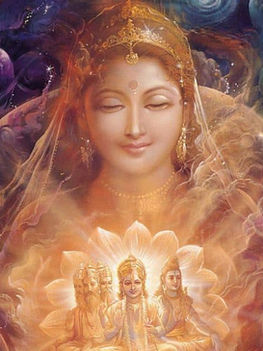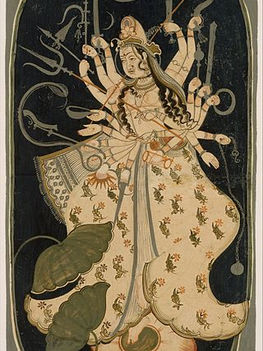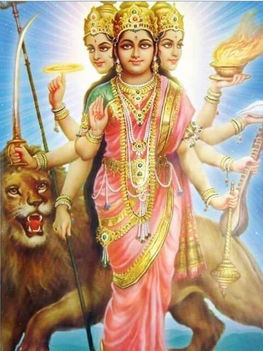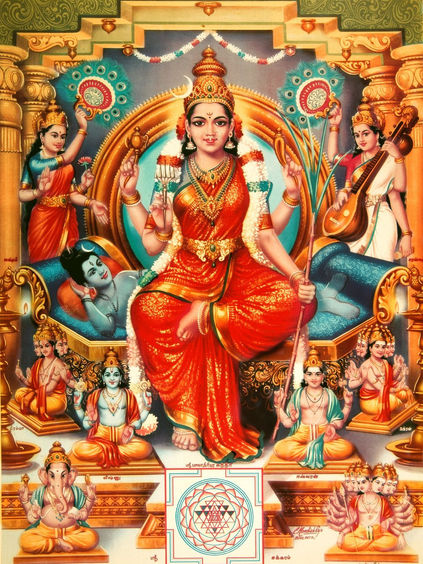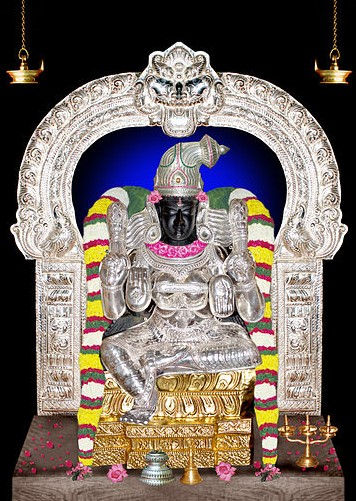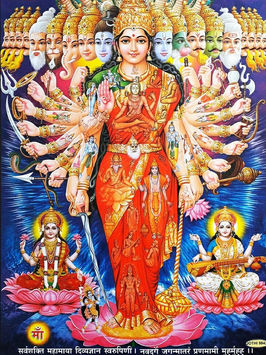Parashakti
Goddess as the supreme and primordial energy
Adi Parashakti
Shakti is the primordial cosmic energy in Hindu culture. In the Shakta tradition, Adi Parashakti, also called Mahashakti and Parama Shakti, is a personification of the primordial energies that create, sustain and destroy. She is the creator of the universe, denoted as the Supreme Goddess. In Srimad Devi Bhagwat Purana, she is called the absolute reality and the owner of the universe who is active in feminine form and latent in masculine form. All gods and goddesses are believed to be her incarnations. She is described as sitting on a throne with a radiant face and is depicted carrying the Surya mudra, pasha, Ankush, and lotus.
"Long ago, at the time of creation, Tripura the Universal Consciousness was all alone. There was nothing other than Her. She, the embodiment of Power, who is Self independent wanted to create; the desire developed. From desire, knowledge was born and then action. From Her three glances the three gods were born. Pashupati represented desire, Hari knowledge and Brahma action. They were looked at by Sankari and became naturally powerful and Truth abiding." ~ Shri Tripura Rahasya, Chapter 10, Verses 18 to 22
Maya
In Shaktisim and Vaishnavism, Adi Parashakti is also worshipped as Maya, the delusion, and classified into three different forms.
-
Yogmaya creates illusions on the gods and guides them on what to do. She also is the one who takes Vishnu to his mystic sleep, called Yognindra. She directed Vishnu to slay the demons Madhu & Kaitabha.
-
Yogmaya is also known as Ekanamsha, which means "the single, portionless one," and as Ekanamsha, she is Vishnu's shakti. The Vrishnis, an ancient Vedic clan, is said to have worshipped the goddess.
-
Yogmaya is also linked to Vindhyavasini. She was born as the daughter of Yashoda, Krishna's foster mother, who was swapped with Krishna by Vasudeva (father of Krishna). When Kansa tried to kill her as a baby, she warned him about his death. Vindhyavasini is also thought to be a manifestation of Durga. Later, she was born as Subhadra, Krishna's sister.
-
Paurnamasi was the mother of Sandipani Muni, Krishna, and Balarama's Guru. She is also known as Yogamaya's incarnation. She ensured that Lord Krishna's pastimes were carried out correctly.
-
Yogmaya is also known as Mahakali in many Shakta traditions.
-
-
As Mahamaya, she creates and destroys her own illusion. She is Adi Parashakti herself, who took manifestations as Matrikas to destroy the army of Shumbha and Nishumbha.
-
As Maya, she tricks living beings and takes anyone to the world of illusion. She encourages greed, anger, and pride.
Tridevi
The Hindu trinity, Brahma, Vishnu, and Shiva, called Trimurti, govern the cosmic regime and in Shaktism, Parashakti gives them the power and instructions to perform their functions. Her manifestation, Saraswati, is the corset of Brahma, the creator of the universe. In the form of Lakshmi, she is the corset of Vishnu, the preserver of the universe. She in her purest manifested form, Parvati or Shakti, is the corset of Shiva, the destroyer. Together these three goddesses are called Tridevi. The three goddesses are the prominent goddesses in many Hindu cultures and are considered the highest aspects of the divine in the feminine form, or Shakti. They emphasize different aspects of divine feminine energy. Each goddess embodies unique characteristics and plays an important role in the cosmic order. Read more: Saraswati, Lakshmi & Parvati
Mahasaraswati, Mahalakshmi, and Mahakali, who are also regarded as the Tridevi, represent warrior manifestations of Shakti. In the Devi Mahatmyam, Mahakali is described as the Yoganidra of Vishnu, while Mahalakshmi is the one who vanquished the buffalo demon Mahishasura, and Mahasaraswati defeated Shumbha-Nishumbha. All three are forms of Shakti, representing the highest aspect of the cosmos. Additionally, they are considered different forms of Saraswati, Lakshmi, and Parvati, also known as Kali.
Mahakali is Yogmaya herself, and a personification of reality and cosmic order. She is depicted with ten heads, ten feet, and ten arms, carrying various attributes which vary in different accounts. Read More: Kali
Mahalakshmi is described as having eighteen arms, holding a battle-axe, maze, arrow, thunderbolt, lotus, bow, water-pot, cudgel, lance, sword, shield, conch, bell, wine-cup, trident, noose and discus. She is often portrayed slaying Mahisaura. Read More: Durga
Mahasarswati, also known as Kausiki, has eight arms and carries a bell, a trident, a ploughshare, a conch, a pestle, a discus, a bow, and an arrow. She has a fair complexion, and her name means "woman of the cell," which outlines how she emerged from Parvati's fair skin.
Lalita Tripura Sundari
Tripura Sundari, also known as Sodashi, Rajarajeswari, and Lalita, is a supreme manifestation in the Srikula tradition of Shaktism. Her name translates as "who is beautiful in three states of consciousness." She is often portrayed iconographically as a 16-year-old girl (thus the name "Shodashi") seated on a lotus that rests on Sadashiva's recumbent body, which rests on a throne whose legs are the gods Brahma, Vishnu, Isvara, and Rudra. In certain accounts, the lotus sprouts from Shiva's navel.
She is also one of the ten Mahavidyas, the ten wisdom goddesses, and in Tripura Rahasya, she is the only entity that existed before the creation of the universe. She created the Trimurti and began the process of creating the universe.
"Long ago, at the time of creation, Tripura the Universal Consciousness was all alone. There was nothing other than Her. She, the embodiment of Power, who is Self independent wanted to create; the desire developed. From desire, knowledge was born and then action. From Her three glances the three gods were born. Pashupati represented desire, Hari knowledge and Brahma action. They were looked at by Sankari and became naturally powerful and Truth abiding." ~ T. B. Lakshmana Rao, Shri Tripura Rahasya (Mahatmya Khanda), Chapter 10, Verses 18 to 22
Ammavaru
Ammavaru is a village goddess worshipped in South India, mainly in the states of Andhra Pradesh and Telangana. She is considered to be the celestial mother who laid the egg that gave birth to Brahma, Shiva, and Vishnu. She, like Adi Parashakti or Lalita Tripura Sundari, is said to have existed before time began.
While the term "Ammavaru" typically refers to the Mother Goddess, the specific characteristics, attributes, and stories associated with Ammavaru can vary depending on local beliefs and customs. Her devotion is profoundly ingrained in the cultural fabric of the different regions. The ceremonies and practices linked with Ammavaru varied among temples and regions, reflecting the diversity of Mother Goddess devotion in South India.
Other Goddesses
as the Supreme Entity
-
In Shaivism, Parvati is regarded as a complete incarnation of Adi Parashakti. And the goddess is often portrayed as the supreme goddess.
-
Prominent Hindu goddesses, Durga and Kali, are often portrayed as the mother of the universe and regarded as the principal of Shakti.
-
Bhuvaneshvari is one of the ten Mahavidya goddesses and she is identified as Adi Parashakti in the Devi Bhagavatam. Her name means "Queen of the universe".
-
In Vaishnavism, where followers consider Vishnu as the Supreme Lord, Lakshmi is the primordial Goddess, and all other goddesses are said to be her manifestations,
-
Kushmanda is one of the nine forms of Durga and is believed to be the Adi Parashakti and portrayed as the creator of the universe.
Hiranyagarbha
Hindu scriptures including the Vedas and Upanishads contain the concept of Hinanyagarbha. "Hiranyagarbha" is a compound word comprised of the Sanskrit words "hiranya," which means "golden," and "garbha," which means "womb or embryo." Many people refer to it as the "golden embryo," "golden womb," or "golden egg." In Hindu cosmology, Hiranyagarbha stands for the cosmic or universal womb from which the universe and all of creation emerge. Hiranyagarbha is regarded as the source or beginning of all things because it is thought to possess the ability for all forms of creation.
"On mighty waters floated the universal egg of the Golden Womb, Hiranyagarbha, which gave birth to the flame of life, the One Spirit of all the Gods." ~ Rig Veda (X.121)

